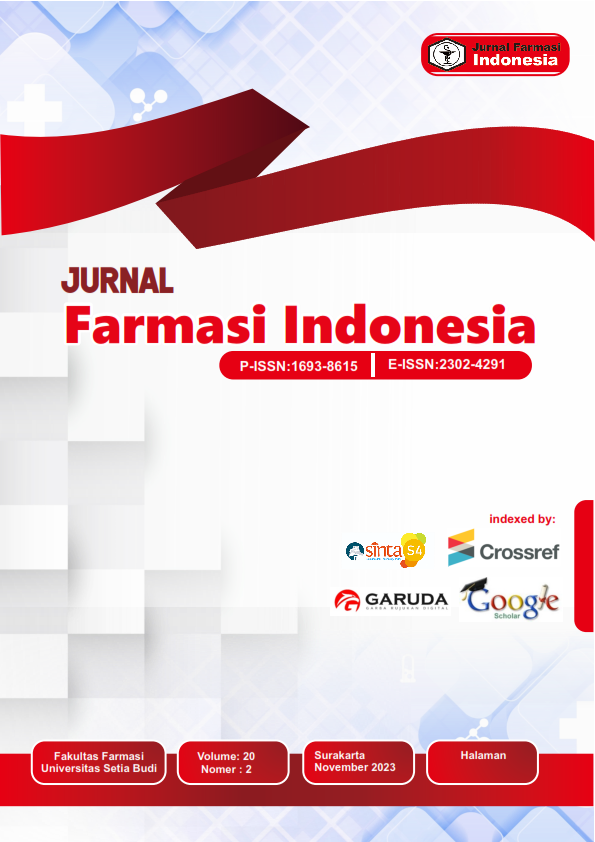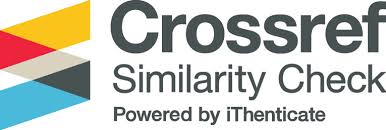In Silico Pharmacokinetic and Toxicity Analysis on Clitoria Ternatea Flower
Abstract
This study explores the pharmacokinetic and toxicity aspects of Clitoria ternatea, which is well-known in traditional medicine for its promising pharmacological potential. Using computational methods, research seeks to unravel the interaction of active compounds in the human body, predicting not only pharmacokinetic properties but also exploring the correlation between chemical structure and parameters such as lipophilicity and P-glycoprotein substrate status, which improves our understanding of the compound's behaviour. The urgency of this research stems from the need for a safe source of therapeutics. Through in-depth in silico toxicity assessments, potential side effects of compounds are carefully identified, ensuring a comprehensive safety evaluation. This important step lays the foundation for responsible pharmacological development. This research introduces a new perspective on exploring traditional medicinal plants, emphasising the importance of safe therapeutic alternatives. The ultimate goal is to establish a solid foundation to further develop C. ternatea as a valuable resource for pharmacological applications and advance natural medicine. The results revealed many compounds with significant pharmacological potential, which show promise for future natural medicine applications. However, the imperative for additional research and experimental validation underscores our commitment to understanding the pharmacological and toxicological aspects of these compounds.
References
[2] A. M. Marpaung, “Tinjauan manfaat bunga telang (clitoria ternatea l.) bagi kesehatan manusia,” Journal of Functional Food and Nutraceutical, vol. 1, no. 2, pp. 63–85, Feb. 2020, doi: 10.33555/JFFN.V1I2.30.
[3] W. F. Afrianto, F. TAMNGE, and L. N. HASANAH, “Review: A relation between ethnobotany and bioprospecting of edible flower Butterfly Pea (Clitoria ternatea) in Indonesia,” Asian Journal of Ethnobiology, vol. 3, no. 2, Oct. 2020, doi: 10.13057/ASIANJETHNOBIOL/Y030202.
[4] N. F. A. M. Zian et al., “Mapping Molecular Networks within Clitoria ternatea Linn. against LPS-Induced Neuroinflammation in Microglial Cells, with Molecular Docking and In Vivo Toxicity Assessment in Zebrafish,” Pharmaceuticals, vol. 15, no. 4, p. 467, Apr. 2022, doi: 10.3390/PH15040467/S1.
[5] N. A. Binte and A. Poh, “Investigation of the Colour Changes of Clitoria ternatea in Different pH Conditions”.
[6] G. B. Escher, M. Wen, L. Zhang, N. D. Rosso, and D. Granato, “Phenolic composition by UHPLC-Q-TOF-MS/MS and stability of anthocyanins from Clitoria ternatea L. (butterfly pea) blue petals,” Food Chem, vol. 331, p. 127341, Nov. 2020, doi: 10.1016/J.FOODCHEM.2020.127341.
[7] A. A. Margret, V. Dhayabaran, S. Suvaithenamudhan, and S. Parthasarathy, “Analysing the antidepressant and drug efflux competence of Clitoria ternatea L. as P-glycoprotein inhibitor to facilitate blood brain barrier,” Acta Sci Biol Sci, vol. 41, no. 1, p. e46629, Dec. 2019, doi: 10.4025/actascibiolsci.v41i1.46629.
[8] R. R. Multisona, S. Shirodkar, M. Arnold, and A. Gramza-Michalowska, “Clitoria ternatea Flower and Its Bioactive Compounds: Potential Use as Microencapsulated Ingredient for Functional Foods,” Applied Sciences 2023, Vol. 13, Page 2134, vol. 13, no. 4, p. 2134, Feb. 2023, doi: 10.3390/APP13042134.
[9] M.- RAJAMANICKAM, “Isolation and Characterizations of new alkaloid 3-deoxy- 3, 11-epoxy cephalotaxine from Clitoria ternatea,” Journal of Drug Delivery and Therapeutics, vol. 9, no. 4-A, pp. 458–462, Aug. 2019, doi: 10.22270/JDDT.V9I4-A.3472.
[10] K. Linggam, S. Ramanathan, S. Sasidharan, and S. M. Mansor, “Toxicity evaluation of methanol extract of clitoria ternatea L. Leaf,” Malaysian Journal of Medicine and Health Sciences, vol. 8, no. 2, pp. 33–39, 2012, Accessed: Jun. 25, 2023. [Online]. Available: https://www.researchgate.net/publication/288117872
[11] P. Rani, B. K. Rajak, and D. V. Singh, “Physicochemical parameters for design and development of lead herbicide molecules: Is ‘Lipinski’s rule of 5′ appropriate for herbicide discovery?,” Pest Manag Sci, vol. 79, no. 5, pp. 1931–1943, May 2023, doi: 10.1002/PS.7367.
[12] R. Roskoski, “Rule of five violations among the FDA-approved small molecule protein kinase inhibitors,” Pharmacol Res, vol. 191, p. 106774, May 2023, doi: 10.1016/J.PHRS.2023.106774.
[13] K. M. Al Azzam, “SwissADME and pkCSM Webservers Predictors: an integrated Online Platform for Accurate and Comprehensive Predictions for In Silico ADME/T Properties of Artemisinin and its Derivatives,” Kompleksnoe Ispolzovanie Mineralnogo Syra = Complex use of mineral resources, vol. 325, no. 2, pp. 14–21, Jun. 2023, doi: 10.31643/2023/6445.13.
[14] B. Bakchi et al., “An overview on applications of SwissADME web tool in the design and development of anticancer, antitubercular and antimicrobial agents: A medicinal chemist’s perspective,” J Mol Struct, vol. 1259, p. 132712, Jul. 2022, doi: 10.1016/J.MOLSTRUC.2022.132712.
[15] E. Benfenati, Q. Chaudhry, G. Gini, and J. Lou Dorne, “Integrating in silico models and read-across methods for predicting toxicity of chemicals: A step-wise strategy,” Environ Int, vol. 131, p. 105060, Oct. 2019, doi: 10.1016/J.ENVINT.2019.105060.
[16] H. K. Shin, R. Huang, and M. Chen, “In silico modeling-based new alternative methods to predict drug and herb-induced liver injury: A review,” Food and Chemical Toxicology, vol. 179, p. 113948, Sep. 2023, doi: 10.1016/J.FCT.2023.113948.
[17] P. K. P. Krishnamoorthy et al., “In-silico study reveals immunological signaling pathways, their genes, and potential herbal drug targets in ovarian cancer,” Inform Med Unlocked, vol. 20, p. 100422, Jan. 2020, doi: 10.1016/J.IMU.2020.100422.













